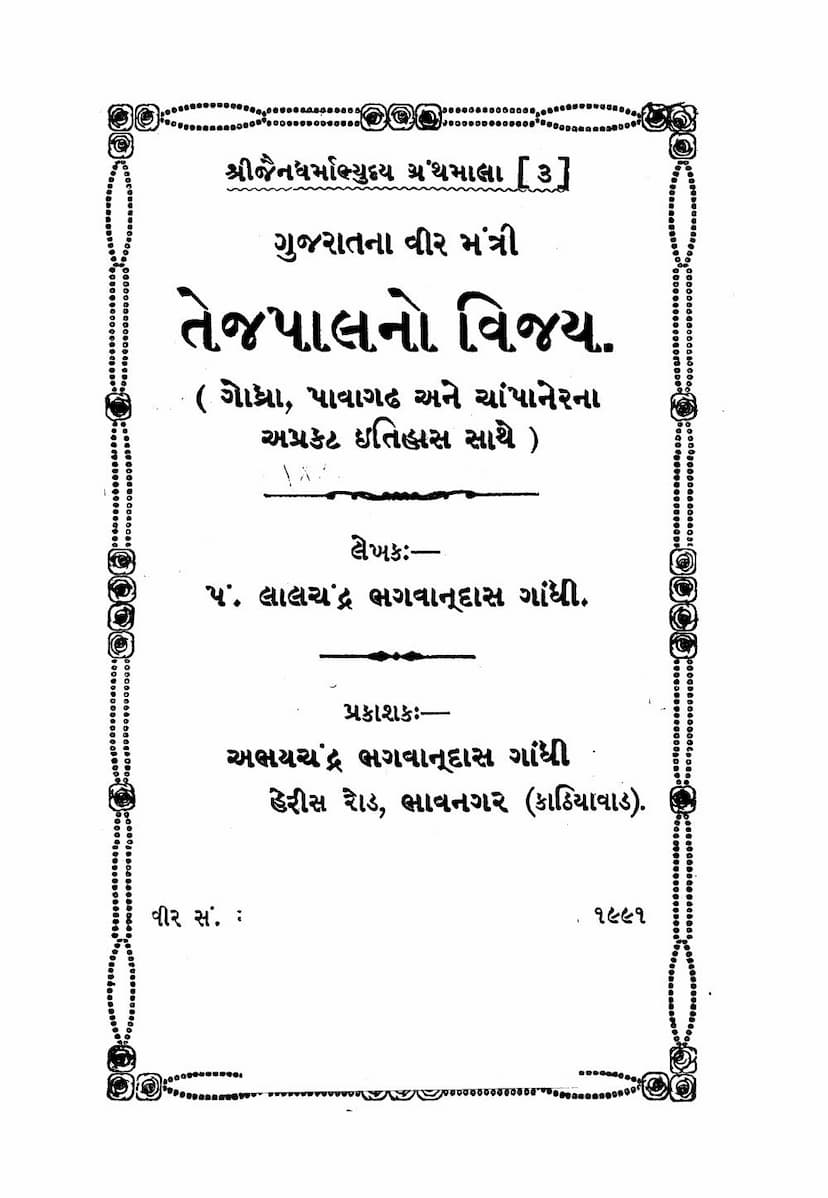Tejpalno Vijay
Added to library: September 2, 2025

Summary
Here is a comprehensive summary of the Jain text "Tejpalno Vijay" by Lalchandra Bhagwandas Gandhi:
Book Title: Tejpalno Vijay (The Victory of Tejpal) Author: Pt. Lalchandra Bhagwandas Gandhi Publisher: Abhaychandra Bhagwandas Gandhi Catalog Link: https://jainqq.org/explore/032143/1
Overall Summary:
"Tejpalno Vijay" is a historical narrative detailing the life and achievements of the renowned Jain minister Tejpal, particularly focusing on his military victory over the king Ghoghul of Gandhra. The book also delves into the historical context of the regions of Gandhra, Pavagadh, and Champaner, highlighting the presence and contributions of the Svetambara Jain community in these areas. The author, Lalchandra Bhagwandas Gandhi, aims to present an accurate historical account, correcting what he perceives as misrepresentations and fictionalizations by some contemporary Gujarati novelists about historical figures and Jainism.
Key Themes and Content:
-
Introduction and Author's Intent: The book begins with a dedication to history enthusiasts. The author explains that this work was initially intended for a special issue of "Jain Dharma Prakash" but was later decided to be published as a book due to its historical significance, incorporating previously unpublished history of Akota, Godhra, Pavagadh, and Champaner. The author expresses his concern over distorted historical accounts created by some writers, which he aims to rectify with factual evidence.
-
Tribute to Tejpal and his Wife Anupama: The book starts with a "Smarañjali" (Tribute) dedicated to the author's late wife, Anupama, drawing a parallel between her virtues and those of Tejpal's wife, Anupama. It highlights Tejpal's significant memorial constructions, including the Anupam Sarovar and the Lūnasiha-Vasahi temple at Shatrunjay, and his own and his wife's statues at Abu, suggesting the Taj Mahal as a later inspiration for such memorials. The author laments the premature death of his wife, recounting her virtuous life and peaceful passing.
-
Historical Context and Tejpal's Achievements:
- Akota: The book begins by discussing Akota, mentioning its historical significance as Akotakpur in the 9th century Vikram era and its connection to the Rashtrakuta king Karka II.
- Gandhra and Ghoghul: A significant portion details the conflict between Minister Tejpal and the Ghoghul king of Gandhra in the late 13th century Vikram era. The author references an Apabhramsa text from 1274 Vikram era mentioning King Karna of the Chalukya dynasty in Gandhra, suggesting Ghoghul might have been his descendant. The text includes vivid descriptions of Gandhra city and its ruler Ghoghul's character, who was portrayed as unjust and exploitative.
- The Conflict: The narrative details the diplomatic mission sent by Minister Vastupal and Tejpal to Ghoghul, conveying King Viradhaval's message. Ghoghul's arrogant and insulting response, including sending symbolic gifts like a kajal box and a sari, led to Tejpal's direct military intervention.
- Tejpal's Military Campaign: The book elaborates on Tejpal's strategic approach, including sending a detachment to raid Gandhra's borders while he followed with the main army. Ghoghul, provoked by the cattle-lifting, engaged Tejpal's forces. The narrative highlights Tejpal's courage and leadership in the battle, culminating in Ghoghul's defeat, capture, and humiliation.
- Aftermath of the Victory: Following the victory, Tejpal established his nephew Singhsen as the ruler of Gandhra. He then proceeded to Vadodara, where he revived the dilapidated temple of Lord Parshvanath. The text also mentions his contributions in Utkot (Akota), Vansara, Dabhoi, and other places, including the construction of temples, reservoirs, and fortifications.
-
Pavagadh and Champaner History (Svetambara Jain Perspective):
- Early Jain Presence: The book traces the Jain history in these regions from the 12th century Vikram era, mentioning the establishment of the Achalgachha by Acharya Rakshit.
- Tejpal's Contributions: It details Tejpal's construction of the Sarvatobhadra Prāsāda at Pavagadh in 1497 Vikram era. The book also discusses how stone pillars for the Nandishwar Karma Sthala on Shatrunjay were brought from Pavagadh.
- Later Jain Activities: The text covers various activities of Svetambara Jains in Champaner and Pavagadh from the 15th to the 20th century Vikram era, including temple constructions, installations of idols, and the patronage of Jain monks and scholars by rulers like Jayasinh Chauhan and various Muslim Sultans. It mentions rulers like Jayasinh Chauhan, Mandlik of Junagadh, and Kumbhakarna of Mewar being influenced by Jain scholars like Somdev Suri.
- Historical Records: The author references various inscriptions, palm-leaf manuscripts, and historical chronicles to support his narrative, including the works of poets like Jayasingh Suri, Hemvijay Suri, and others.
-
Critique of Modern Literature: Gandhi strongly criticizes contemporary novelists (like K.M. Munshi) for what he considers fictionalization and misrepresentation of Jain history and figures. He argues that these authors, while claiming to uphold Gujarati culture, distort facts for artistic license, unfairly criticizing Jain society and its prominent figures. He emphasizes the importance of historical accuracy and the need to understand the true contributions of Jain patrons and scholars.
-
Chronology and Place Names: The book provides a detailed index of historical place names and figures mentioned in the text, serving as a valuable reference for researchers.
-
Author's Bibliography: A significant portion of the book lists the author's (Pt. Lalchandra Bhagwandas Gandhi's) extensive literary contributions, including research, editing, translation, and authorship of numerous articles and books on Jain history, literature, and philosophy. This demonstrates his deep commitment to Jain scholarship.
Significance of the Book:
"Tejpalno Vijay" is important for several reasons:
- It offers a detailed, evidence-based account of Minister Tejpal's military victory and his extensive contributions to Jainism and the regions of Gujarat.
- It sheds light on the historical presence and influence of the Svetambara Jain community in Pavagadh and Champaner.
- It serves as a critique and correction of what the author views as inaccurate and biased historical portrayals in modern literature.
- It highlights the author's own dedication to Jain research and scholarship through his extensive bibliography.
In essence, the book is a scholarly endeavor to preserve and present the true history of a significant Jain minister and the Jain community's role in the historical landscape of Gujarat, emphasizing valor, piety, and cultural patronage.